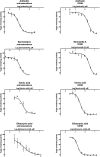Potent inhibitors of equine steroid isomerase EcaGST A3-3
- PMID: 30897163
- PMCID: PMC6428247
- DOI: 10.1371/journal.pone.0214160
Potent inhibitors of equine steroid isomerase EcaGST A3-3
Abstract
Equine glutathione transferase A3-3 (EcaGST A3-3) belongs to the superfamily of detoxication enzymes found in all higher organisms. However, it is also the most efficient steroid double-bond isomerase known in mammals. Equus ferus caballus shares the steroidogenic pathway with Homo sapiens, which makes the horse a suitable animal model for investigations of human steroidogenesis. Inhibition of the enzyme has potential for treatment of steroid-hormone-dependent disorders. Screening of a library of FDA-approved drugs identified 16 out of 1040 compounds, which at 10 μM concentration afforded at least 50% inhibition of EcaGST A3-3. The most potent inhibitors, anthralin, sennoside A, tannic acid, and ethacrynic acid, were characterized by IC50 values in the submicromolar range when assayed with the natural substrate Δ5-androstene-3,17-dione.
Conflict of interest statement
The authors have declared that no competing interests exist.
Figures




Similar articles
-
Characterization of equine GST A3-3 as a steroid isomerase.J Steroid Biochem Mol Biol. 2018 Apr;178:117-126. doi: 10.1016/j.jsbmb.2017.11.011. Epub 2017 Nov 24. J Steroid Biochem Mol Biol. 2018. PMID: 29180167
-
Structural and functional analysis of the inhibition of equine glutathione transferase A3-3 by organotin endocrine disrupting pollutants.Environ Pollut. 2021 Jan 1;268(Pt B):115960. doi: 10.1016/j.envpol.2020.115960. Epub 2020 Oct 29. Environ Pollut. 2021. PMID: 33162212
-
FDA-approved drugs and other compounds tested as inhibitors of human glutathione transferase P1-1.Chem Biol Interact. 2013 Sep 5;205(1):53-62. doi: 10.1016/j.cbi.2013.06.003. Epub 2013 Jun 13. Chem Biol Interact. 2013. PMID: 23769903
-
Adaptive response to glutathione S-transferase inhibitors.Br J Cancer Suppl. 1996 Jul;27:S93-8. Br J Cancer Suppl. 1996. PMID: 8763856 Free PMC article. Review. No abstract available.
-
Glutathione Transferases as Efficient Ketosteroid Isomerases.Front Mol Biosci. 2021 Nov 22;8:765970. doi: 10.3389/fmolb.2021.765970. eCollection 2021. Front Mol Biosci. 2021. PMID: 34881290 Free PMC article. Review.
Cited by
-
Characterization of Dog Glutathione Transferase P1-1, an Enzyme Relevant to Veterinary Medicine.Int J Mol Sci. 2021 Apr 15;22(8):4079. doi: 10.3390/ijms22084079. Int J Mol Sci. 2021. PMID: 33920860 Free PMC article.
-
Marmoset glutathione transferases with ketosteroid isomerase activity.Biochem Biophys Rep. 2021 Jul 12;27:101078. doi: 10.1016/j.bbrep.2021.101078. eCollection 2021 Sep. Biochem Biophys Rep. 2021. PMID: 34286113 Free PMC article.
-
In silico prediction models for thyroid peroxidase inhibitors and their application to synthetic flavors.Food Sci Biotechnol. 2022 Mar 12;31(4):483-495. doi: 10.1007/s10068-022-01041-y. eCollection 2022 Apr. Food Sci Biotechnol. 2022. PMID: 35464247 Free PMC article.
References
-
- Lu NZ, Wardell SE, Burnstein KL, Defranco D, Fuller PJ, Giguere V, et al. International Union of Pharmacology. LXV. The pharmacology and classification of the nuclear receptor superfamily: glucocorticoid, mineralocorticoid, progesterone, and androgen receptors. Pharmacol Rev. 2006. December 1;58(4):782–97. 10.1124/pr.58.4.9 - DOI - PubMed
Publication types
MeSH terms
Substances
LinkOut - more resources
Full Text Sources

